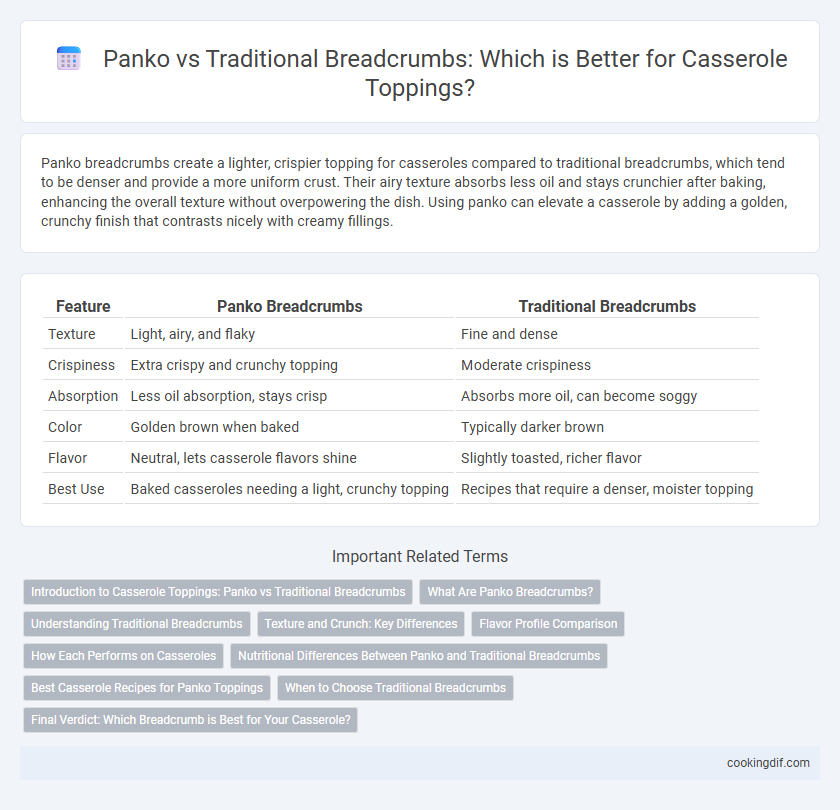Panko breadcrumbs create a lighter, crispier topping for casseroles compared to traditional breadcrumbs, which tend to be denser and provide a more uniform crust. Their airy texture absorbs less oil and stays crunchier after baking, enhancing the overall texture without overpowering the dish. Using panko can elevate a casserole by adding a golden, crunchy finish that contrasts nicely with creamy fillings.
Table of Comparison
| Feature | Panko Breadcrumbs | Traditional Breadcrumbs |
|---|---|---|
| Texture | Light, airy, and flaky | Fine and dense |
| Crispiness | Extra crispy and crunchy topping | Moderate crispiness |
| Absorption | Less oil absorption, stays crisp | Absorbs more oil, can become soggy |
| Color | Golden brown when baked | Typically darker brown |
| Flavor | Neutral, lets casserole flavors shine | Slightly toasted, richer flavor |
| Best Use | Baked casseroles needing a light, crunchy topping | Recipes that require a denser, moister topping |
Introduction to Casserole Toppings: Panko vs Traditional Breadcrumbs
Panko breadcrumbs create a lighter, crunchier casserole topping characterized by their flaky, airy texture derived from Japanese bread-making techniques. Traditional breadcrumbs offer a denser, more uniform crust that absorbs more moisture, providing a richer, slightly chewy finish. Choosing between panko and traditional breadcrumbs impacts the casserole's texture and flavor profile, with panko preferred for crispness and traditional for robust coverage.
What Are Panko Breadcrumbs?
Panko breadcrumbs are a type of Japanese breadcrumb made from crustless white bread, resulting in light, airy, and flaky crumbs that create a crispier topping compared to traditional breadcrumbs. Unlike traditional breadcrumbs, which are finely ground and dense, panko absorbs less oil and stays crunchier when baked atop casseroles. Their unique texture enhances the crispness and visual appeal of casserole toppings, making them a preferred choice for achieving a crunchy, golden crust.
Understanding Traditional Breadcrumbs
Traditional breadcrumbs are made from dried and ground white or whole wheat bread, offering a finer texture that crisps evenly when baked atop casseroles. They absorb moisture effectively, creating a cohesive topping that enhances flavor while preventing sogginess. Unlike panko, traditional breadcrumbs provide a denser, more uniform crust, ideal for classic casserole finishes.
Texture and Crunch: Key Differences
Panko breadcrumbs provide a lighter, airier texture with larger, coarser flakes that create a crispier and crunchier topping for casseroles compared to traditional breadcrumbs. Traditional breadcrumbs offer a denser, finer texture that results in a softer, less crunchy crust. Choosing panko enhances the topping's crispiness, while traditional breadcrumbs contribute to a more uniform, slightly chewy finish.
Flavor Profile Comparison
Panko breadcrumbs create a lighter, crispier topping on casseroles due to their airy, flaky texture, enhancing the dish with a subtle, toasted flavor that remains delicate and not overpowering. Traditional breadcrumbs offer a denser, more uniform crunch with a richer, buttery taste that contributes a deeper, savory note to the casserole's flavor profile. Choosing between panko and traditional breadcrumbs depends on whether a lighter, crisp finish or a heartier, robust topping complements the casserole's overall taste.
How Each Performs on Casseroles
Panko breadcrumbs create a lighter, crispier topping on casseroles due to their larger flakes and airy texture, which brown more evenly and provide superior crunch. Traditional breadcrumbs offer a denser, more compact topping that can absorb moisture, resulting in a softer, chewier crust. In casseroles, panko is often preferred for a crisp finish that resists sogginess better than traditional breadcrumbs.
Nutritional Differences Between Panko and Traditional Breadcrumbs
Panko breadcrumbs contain fewer calories and less fat compared to traditional breadcrumbs due to their coarser texture and airier composition, which results in a lighter topping for casseroles. Traditional breadcrumbs often have higher sodium content and may include added preservatives, impacting overall nutritional value. Choosing panko can contribute to a crispier casserole topping with lower carbohydrate density and reduced oil absorption during baking.
Best Casserole Recipes for Panko Toppings
Panko breadcrumbs create a crispier, lighter topping for casseroles compared to traditional breadcrumbs, enhancing texture and presentation. Popular casserole recipes that benefit from panko toppings include chicken divan, baked macaroni and cheese, and green bean casserole, where the golden, airy crunch elevates the dish. Using panko also allows for better absorption of butter or seasoning, resulting in a more flavorful and satisfying topping layer.
When to Choose Traditional Breadcrumbs
Traditional breadcrumbs create a denser, more uniform topping for casseroles, ideal when a moist, cohesive crust is desired. They absorb sauces and moisture better, preventing the topping from becoming too crunchy or dry. Choose traditional breadcrumbs for casseroles like tuna noodle or chicken divan, where a soft, integrated texture complements the dish.
Final Verdict: Which Breadcrumb is Best for Your Casserole?
Panko breadcrumbs provide a lighter, crispier topping that enhances casseroles with a delicate crunch, creating a more textured finish compared to traditional breadcrumbs. Traditional breadcrumbs offer a denser, more uniform crust that absorbs sauces well, making them ideal for classic, hearty casseroles. Choose panko for a golden, airy crust that stays crisp longer, or opt for traditional breadcrumbs when you want a moist, flavorful topping that complements rich ingredients.
Panko vs traditional breadcrumbs for topping Infographic

 cookingdif.com
cookingdif.com